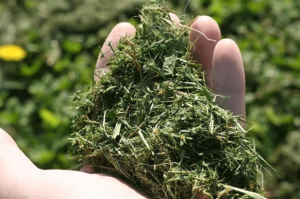Latest Posts
- Have a purpose when backyardingAugust 5 2021
- Study: Time outside alters our microbiomeAugust 4 2021
- Happy National Mutt Day from Mo-MoJuly 27 2021
- New home? Avoid these common mistakes in your yard.July 26 2021
- Infographic: Plan a backyard staycation this summerJuly 22 2021
Categories
Archive
August 6th
Grasscycling saves time & money (+ benefits the environment)

When it comes to mowing, are you in the catch-the-clippings camp or do you prefer to let them lie?
Turns out, there are lots of good reasons to leave your grass clippings on the yard to decompose – a practice dubbed “grasscycling”. According to the University of California’s statewide integrated pest management program, grasscycling requires you to mow your yard at the right frequency, cut the grass to the proper height for the species, and remove no more than one-third of a leaf blade every time you mow.
Good for grass health. Grasscycling helps boost yard health, naturally. Your yard has been under a lot of stress with the dog days of summer, especially if you live in an area prone to drought. Grasscycling is one way you can help improve your lawn’s strength and overall health. The cut grass blades left on the lawn will decompose quickly and return nutrients to the lawn.
Equipment makes it easy. Some people use a mulching or recycling mower for grasscycling. These mowers will cut the clippings into tiny pieces and return them to the lawn to decompose.
Save time & waste. An added bonus? You save the time and costs for bagging, and you avoid adding more waste to landfills.
Proper procedure is key. Grasscycling will only be beneficial if you are removing small clippings at a time, so proper mowing and equipment are essential. Grasscycling may slightly increase thatch buildup on your lawn, but the benefits outweigh the disadvantages in most situations. If your grass is too wet or has not been mowed regularly and is very tall, grasscycling should not be done, as this could lead to thatch buildup.
For more information about ways to maintain a living landscape, go to TurfMutt.com.





